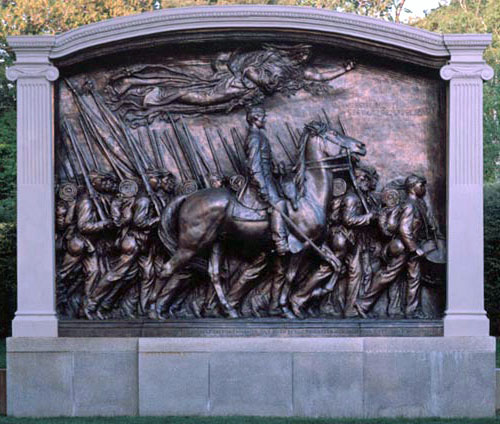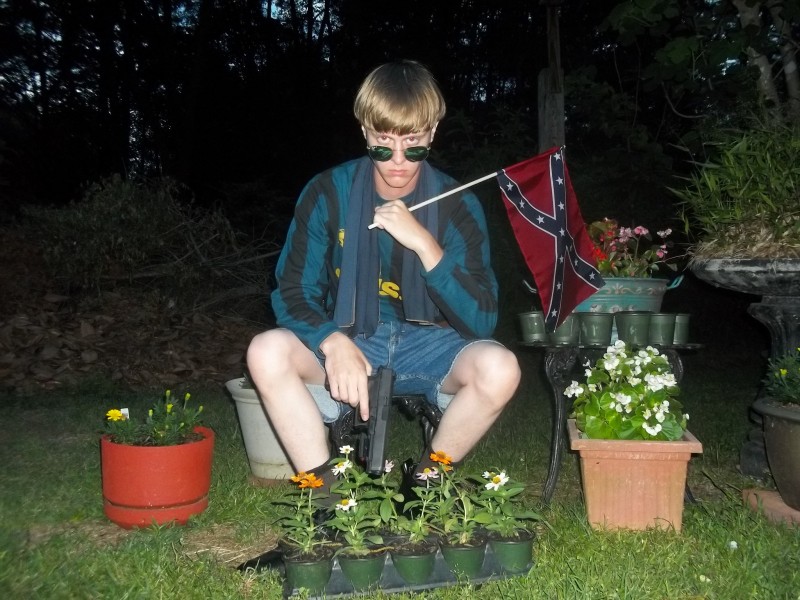Photography and Civil War memory (Part 1)
19 February 2016 – Kristen Treen

Photograph of Robert Gould Shaw Memorial, by Augustus Saint-Gaudens (1848 – 1907). Photo credit: United States National Park Service
Editor’s note: This two-part post continues our series addressing recent debates over Confederate memory and symbolism in the wake of the shooting of nine parishioners at Emanuel African Methodist Episcopal Church in downtown Charleston, South Carolina. Here is the opening post for the series.
As William James gave his oration at the unveiling of the Memorial to Robert Gould Shaw and the 54th Massachusetts in Boston on Memorial Day of 1897, he envisaged a future in which memories of the war were perpetuated in bronze and granite as its photographic record faded away. The extraordinary monument upon which he reflected, he believed, heralded a new kind of engagement with a past that, to so many present at the unveiling, was yet vivid if not as painful as it once had been. James’s own brother had been badly injured during the charge on Fort Wagner on July 18, 1863, in which Shaw perished and 272 of his African American soldiers were killed, wounded, or captured. Yet while William James lingered briefly on the mass graves outside “Fort Wagner’s ancient site” that signified the reality of that event in all its devastation, fear, and loss, he was convinced that “the wild assault and repulse that for a brief space made night hideous on that far-off evening, [has] sunk into the blue gulf of the past, and for the majority of this generation are hardly more than an abstract name, a picture, a tale that is told.”
This new monument was to take the “abstract” names of Shaw, the 54th, and Fort Wagner and transform them into bywords for the values of “valor” and “civic courage” that a late-nineteenth-century America, still plagued by racial oppression, political corruption, and increasingly mired in foreign wars, so badly needed.
For James, Shaw and the soldiers of the 54th would become solid symbols, poetic and edifying moral figures, while the “human things,” so quickly “forgotten,” would disappear. By “human things,” James told his listeners, he meant traces of the war that elicited a more intimate response in the way they made the past seem “concrete,” like the “yellow-bleached photograph[s] of soldier[s] of the ‘sixties,” which occasionally found their way into his hands. In spite of the way they struck the viewer with “that odd and vivid look of individuality due to the moment [in which they were] taken,” a look which communicated with startling clarity the “interminable” weight and emotion of those long years, James was convinced that those intricate windows to an individually lived conflict were sure, soon, to “fade utterly.” In their place, “books of history and monuments alone will tell the tale:” memories of the war would endure, yes, but as concept, as ideal, as values elevated and made sacred in bronze.
As much as James’s belief in the Civil War’s monumental transformation has been borne out across the states, his predictions for the afterlife of the Civil War photograph, and the dichotomy he draws between the memorial workings of photograph and monument, were undoubtedly wide of the mark. Scrolling through Twitter or Facebook feeds is enough to convince me of this: countless online repositories–run by academics, public historians, and amateur historians–have emerged in recent years and flood social media with captivating and disturbing photographs. Individuals, Confederate and Federal, in uniform; groups of friends fresh from the enlistment office or the field, the latter posing with cutlery and hard-tack with bowie knives bared; generals on horseback surveying destruction; the wounded recording their disfigurements; new glimpses at the faces of United States Colored Troops; the magic, occasionally, of seeing a soldier’s face in technologically-enhanced color. The variations are endless, and with each new pose or prop comes a new sense of fascination and proximity which is beginning to define a popular interaction with Civil War memory in a way that blurs the line James tries to draw between an immediate, individual past and the values perpetuated by “official” commemorative forms.

Dylann Roof posing with Confederate flag and gun. Photo originally from white supremacist website, posted on NYTimes.com
In the wake of events in Charleston last year and debates about the Confederate flag that followed, I was prompted to think again about the ways in which photographs of Civil War combatants are put to memorial use. It troubled me that a lot of the photographs published after Charleston of the shooter, Dylann Roof, posing defiantly with handgun and Confederate flag, were disturbingly reminiscent of the set jaws and proud arrangements of personal weaponry in many Confederate photographs I’d seen, while what seemed to be his “trademark” impassive stare evoked the striking portraits of Lewis Powell, one of Lincoln’s assassins, in custody.
Roof is an extreme case, but his appropriation of a Confederate past points to the potency of wartime photographs as sites with distinctly affective and corporeal mnemonic functions. As numerous scholars have noted, wartime photography was intentionally rich in gesture, in props, in conscious acts of staging devised by their sitters as a means of addressing those they left at home, of leaving family and friends in no doubt of their allegiance, their intent, or simply the strangeness and terror of the phenomenon of war itself. At the same time as these sitters sought to generate communities of shared feeling through their photographs, there seems to be something about these contemplative yet forthright acts of war that capture the American imagination now, with astonishingly varied results.
Dylann Roof emulated what he saw as physical exemplars of Confederate rebellion and defiance in the staging of his own photographs and the justification of his own violence implicit in them: we cannot know who he addresses in his photographs, but his fantasy of endowing oneself with the authority of the past is astonishingly clear. At the other end of the spectrum, re-enactors study photographs of the war’s living and its dead in their missions to capture the triumphs and sorrows of a national past and to contemplate it, as it were, from within. For many, channeling that past constitutes a kind of religious experience, a form of communion, of grieving, and of remembrance which photography as a medium–in both senses of the word–helps to sanctify. (Check History@Work next week for the conclusion of this post.)
~ Kristen Treen is a Wolfson Scholarship PhD student at the University of Cambridge working on a thesis which examines the impact of the American Civil War’s material culture upon literary form and cultural formation from 1861 to the early twentieth century.



